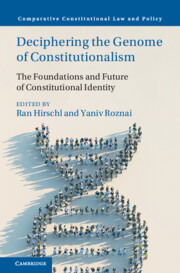Book contents
- Deciphering the Genome of Constitutionalism
- Comparative Constitutional Law and Policy
- Deciphering the Genome of Constitutionalism
- Copyright page
- Contents
- Figures
- Contributors
- Preface
- Acknowledgments
- Introduction
- Part I Foundations, Theory, and Concepts
- Part II Comparative Perspectives
- Part III American Constitutionalism and Constitutional Identity
- 14 “This Is (Not) Who We Are”
- 15 Constitutional Aspirationalism Revisited
- 16 The Constitution at War with Itself
- 17 Constitutional Identity, Constitutional Politics, and Constitutional Revolutions
- 18 American Constitutional Exceptionalism, Constitutional Identity, and Democracy
- Part IV Emerging Trends
- Index
- References
14 - “This Is (Not) Who We Are”
Reflections on 1619 and the Search for a Singular Constitutional Identity*
from Part III - American Constitutionalism and Constitutional Identity
Published online by Cambridge University Press: 14 March 2024
- Deciphering the Genome of Constitutionalism
- Comparative Constitutional Law and Policy
- Deciphering the Genome of Constitutionalism
- Copyright page
- Contents
- Figures
- Contributors
- Preface
- Acknowledgments
- Introduction
- Part I Foundations, Theory, and Concepts
- Part II Comparative Perspectives
- Part III American Constitutionalism and Constitutional Identity
- 14 “This Is (Not) Who We Are”
- 15 Constitutional Aspirationalism Revisited
- 16 The Constitution at War with Itself
- 17 Constitutional Identity, Constitutional Politics, and Constitutional Revolutions
- 18 American Constitutional Exceptionalism, Constitutional Identity, and Democracy
- Part IV Emerging Trends
- Index
- References
Summary
The term “identity” often generates questions about the “essence” of the entity being “identified.” Ascriptions of “identity” become controversial inasmuch as given behaviors or traits are viewed as favorable or unfavorable. Within the United States, the rhetorical trope “this is not who we are” has become almost pervasive upon the occurrence of a regrettable, even heinous, act. President Obama had a particular affinity for the phrase. He suggested, for example, that the vicious racism revealed in the 2015 massacre of African Americans in Charleston, South Carolina was aberrant, revealing nothing essential about American culture. The current debate within the United States about the “1619 Project” is all about constitutional and cultural identity. Its adherents argue that American identity is rooted in the white supremacy instantiated in the practice of slavery, dating back to 1619. Opponents emphasize the 1776 Declaration of Independence, with its proclamation that “all men are created equal” and “endowed” with equal “inalienable rights,” as the key marker of American identity. Slavery, which is conceded to have existed, was simply epiphenomenal; “who we are” is defined by the Declaration. Much is thought to ride on ascribing a particular identity to any given country or, more particularly, its constitution.
Keywords
- Type
- Chapter
- Information
- Deciphering the Genome of ConstitutionalismThe Foundations and Future of Constitutional Identity, pp. 179 - 192Publisher: Cambridge University PressPrint publication year: 2024

